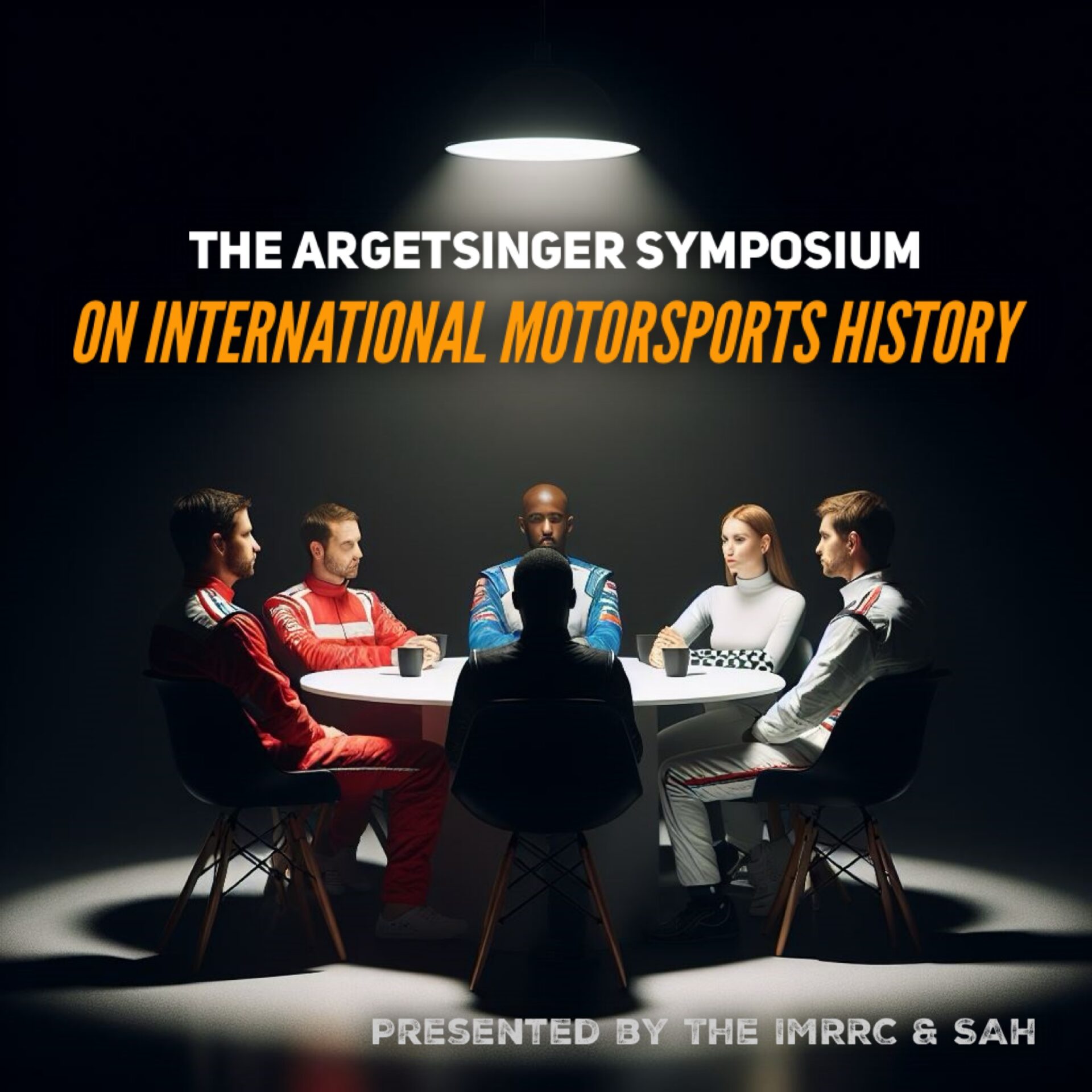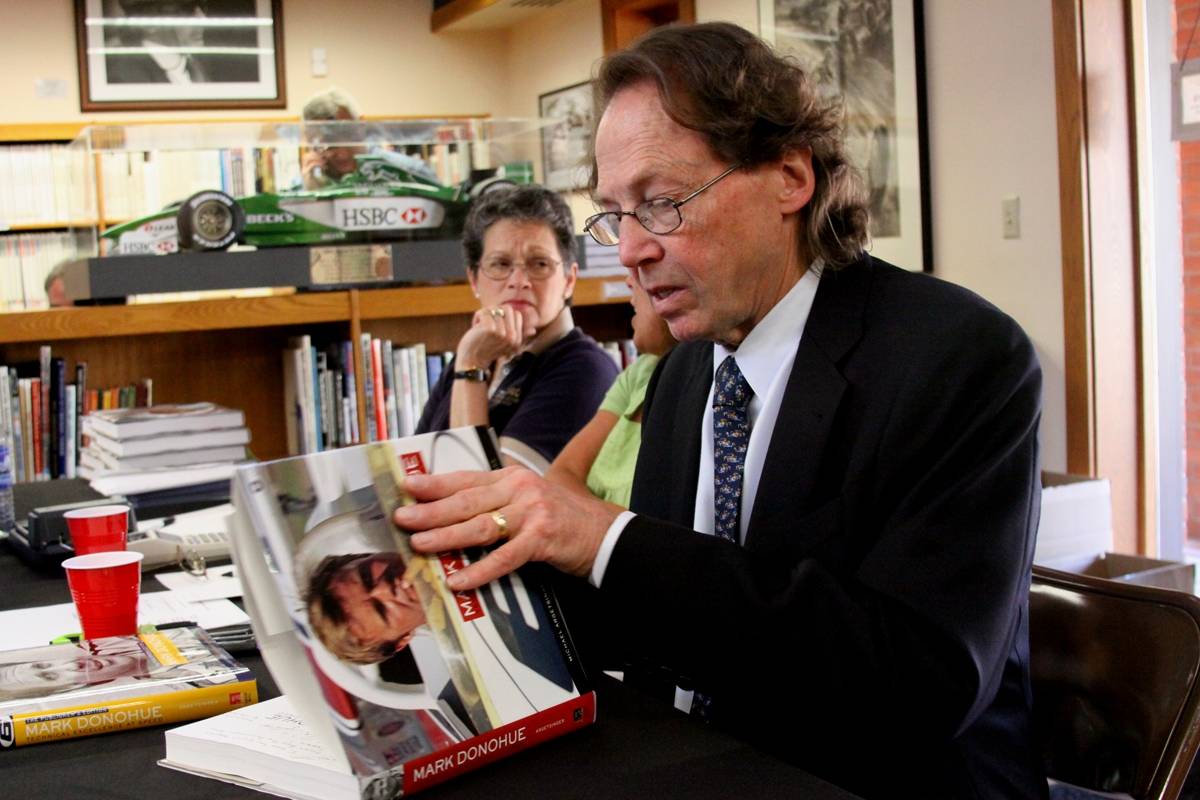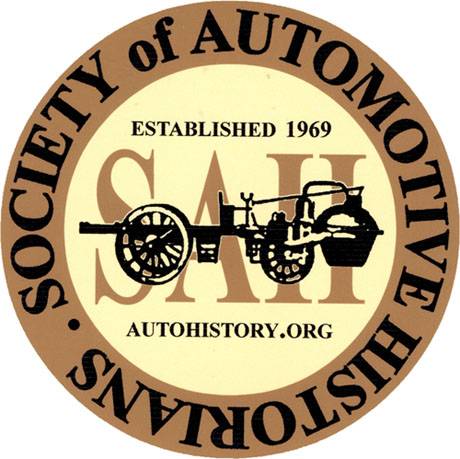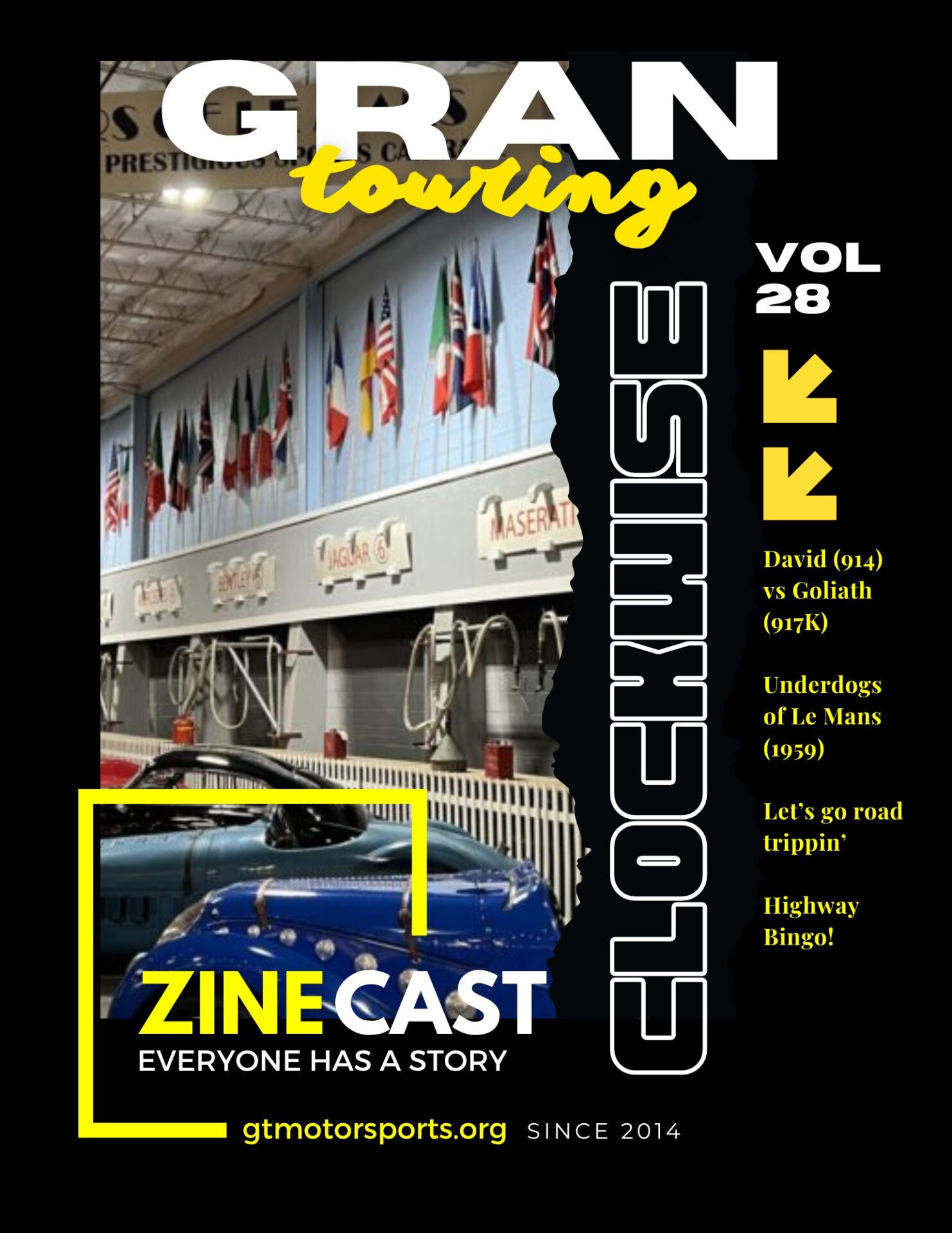Dr. Mark Howell’s presentation for this year’s Symposium Living Loud and Living Fast will explore the connections between musicians and motorsports. The presentation highlights how several well-known professional musicians from diverse genres took their interest in high-performance vehicles to regional, national, and sometimes international levels of motor racing competition.
Tune in everywhere you stream, download or listen!
 |  |  |
- Bio
- Notes
- Transcript
- Livestream
- Learn More
Bio

Mark Howell is a professor of Communications at Northwestern Michigan College. Prior to NMC, he was a visiting assistant professor in the Department of American Thought and Language at Michigan State University.
As a Motorsports historian, Dr. Howell has published numerous articles and two books: From Moonshine to Madison Avenue: A Cultural History of the NASCAR Winston Cup Series (1997) and Motorsports and American Culture: From Demolition Derbies to NASCAR (2014).
Since 2011, he has been a Senior Writer for frontstretch.com, where his essays appear every Wednesday during the racing season. Dr. Howell also spent three years (2001-2003) as a part-time crew member with Brett Bodine Racing in the Monster Energy NASCAR Cup Series, and has worked closely with drivers Hut Stricklin, Kenny Wallace, and Todd Bodine.
Notes
Transcript
[00:00:00] Brake Fix’s History of Motorsports series is brought to you in part by the International Motor Racing Research Center, as well as the Society of Automotive Historians, the Watkins Glen Area Chamber of Commerce, and the Argettsinger family.
Living loud, living fast. Connections between musicians and motorsports by Mark D. Howell. Mark Howell is a professor of communications at Northwestern Michigan College. Prior to NMC, he was a visiting assistant professor at the Department of American Thought and Language at Michigan State University. As a motorsports historian, Dr.
Howell has published numerous articles and two books, From Moonshine to Madison Avenue, a cultural history of the NASCAR Winston Cup Series in 1997, and Motorsports and the American Culture, from Demolition Derbies to NASCAR in 2014. Since 2011, he has been a senior writer for French stretch.com, where his essays appear every Wednesday during the racing season.
Dr. Howell also spent three years from [00:01:00] 2001 to 2003 as a part-time crew member with Brett Bodin racing in the Monster Energy NASCAR Cup series, and has worked closely with NASCAR drivers, Hutt Strickland, Kenny Wallace, and Todd Bodine, Dr. Howell’s presentation for this year’s symposium. Living Loud and Living Fast will explore the connections between musicians and motor sports.
The presentation highlights how several well known professional musicians from diverse genres took their interest in high performance vehicles to regional, national, and sometimes international levels of motor racing competition. Our next topic, living loud, living fast, connections between musicians and motorsports by Mark Howell from Michigan, a frequent presenter here at our events.
Mark, delighted to have you here. It’s all yours. Thank you, Bob. And I will echo everyone’s sentiments that it’s nice to be back in person. We’ve missed getting together here at the [00:02:00] Glenn, and it’s nice to, to be enjoying some time together. Just as kind of an introduction to this topic, I’ve been working on a manuscript the last couple of years.
Looking at the connection between motor sports and the manned space program. And not so much in the technical aspect. I think that’s been covered in quite enough detail. But I’m looking at the personalities. Looking at the connection between astronauts and drivers. A lot of astronauts who were hobbyist drivers.
Some who became professional drivers later in their careers. Um, And, uh, and in doing that research, I stumbled across occasionally names of musicians who sort of fell under the same category as hobbyist racers or, um, in many cases, uh, actually competitive racers. And so that’s where this presentation sort of took shape.
And, uh, so, I will [00:03:00] share some of my most recent findings with you. It might seem challenging to find a direct correlation between country music legend Marty Robbins and heavy metal frontman Vince Neil, but one needs to look no further than an asphalt speedway. Despite their differences in musical genres, clothing styles, and their respective eras in entertainment history, these two outwardly unrelated personalities are more similar than one would think.
That’s because both escaped the demands of the music business by climbing behind the wheel of a race car. Note that I am not focusing on musicians who dabbled in novelty races like the Toyota Pro Celebrity Race held in Long Beach, California between 1977 and 2016. Ted Nugent won the celebrity class in 1983, and Donny Osmond took the celebrity [00:04:00] win in 1991.
But I am not classifying those events as competitive pro only races. And this will be the only time you see these two together in a visual, probably ever in your life. Although as a pro, Ted Nugent did compete in the Baja 1000 on a couple of occasions, as did Mike Nesmith. monkeys. Uh, my focus is on the handful of professional musicians who have spent their leisure time as professional race car drivers.
The two occupations enjoy somewhat of a symbiotic relationship, a unique relationship highlighted by the need for participants in both of these audience oriented, public performance based disciplines to demonstrate numerous essential qualities, including patience, timing, and, uh, uh, uh, uh, uh, uh, uh, uh, uh, uh, uh, Memory recall, teamwork, hand eye coordination, and control.
[00:05:00] While it is the accumulated wealth that, of most professional musicians, that enables them to collect specialized automobiles, it does not, by any means, require them to drive those exotic cars competitively. Motorsports are not for the faint of heart. Racing cars is not only inherently dangerous, but it is prohibitively expensive and both physically and mentally challenging.
Perhaps it is these last two demands that link motorsports to music. Both activities tend to be performed before a paying audience, and both require the participant to be something of an exhibitionist. Any fear of failure must be overshadowed by prodigious confidence. A musician who makes a mistake will recover from their error by staying calm and pushing onward through the song.
A racer who makes a mistake, on the other hand, will hopefully recover enough to, enough control to stay on [00:06:00] course and avoid wrecking their car. One of the first professional musicians to climb behind the wheel of a race car was Johnny Clay, a jazz trumpeter and band leader from England who gave up the music business entirely and moved to Belgium to drive competitively.
Clay made 23 Grand Prix. Starts between 1948 and 1956, scoring his first career victory at the 1950 Grand Prix de Frontier in Sheme, A race. He won again in 1951. In 1953, clay won the Rome rally, and in 1954 he managed to win his class in the 24 hours of lamont. Unfortunately, Clay’s racing career was cut short when he was diagnosed with TB in 1955.
The musician turned racer died the next year at the age of [00:07:00] 39. Johnny Clay transitioned smoothly from a career in music to a career in motor racing. But it’s important to acknowledge that not all musicians who enjoy racing see themselves on a starting grid. Some musicians utilize their creative gifts in admiration of motor racing achievements and history.
The late George Harrison, for example, was a close friend and admirer of Jackie Stewart. Stewart wrote a book in 1972 titled Faster, A Racer’s Diary, which chronicled his 1970 racing season, a year that was scarred by troublesome race cars. Unreliable sponsors, and the on track deaths of two fellow drivers, one of whom, Jochen Rindt, was Stewart’s best friend.
Harrison, who had a collection of racing photographs, spent 1977 traveling the circuit with Stewart. His experiences resulted in the song, Faster, which [00:08:00] reflected on the trials and tribulations of Formula One as seen from Stewart’s perspective. The song appeared on Harrison’s self titled solo album in 1979.
Another musician who put his fascination with motor racing into song was Mark Knopfler. His single, Speedway at Nazareth, which is from 2000, used the challenges of an IndyCar season as a metaphor for life. And in 2010, Mark Knopfler released The car was the one, a single commemorating the life and legacy of the late Mark Donohue.
Mark Knopfler read Donohue’s 1975 autobiography, The Unfair Advantage, and was intrigued by Donohue’s story of being an up and coming racer who wanted a chance to drive the new Shelby Cobra. Ackar Nafler referred to in his song as the one. Mark Nafler borrowed, quote unquote, Donahue’s story from the opening [00:09:00] paragraph of chapter six.
It’s located on page 27 of the second edition, published in September of 2000, and used it for the song’s lyrics. The song is like the book in that the narrative is from Donahue’s perspective. Mark Donahue himself is never mentioned. Knopfler’s song, instead, is all about a young driver’s admiration of a successful peer, the young driver’s desire to win, and the car that helped shape the young driver’s career.
For many other musicians enamored with motorsports, the allure of competition is too powerful to ignore. Sadly, for these aspiring champions, ignoring their urges would have been a better course of action. As in the case of Andrew Ridgely, one half of the famed pop duo, Wham!, he’s on the left in this photograph.
After his tenure with the group, Ridgely took [00:10:00] his money and his energy and chased his dreams of motor racing glory. He took up residence in Monaco and began racing in Formula 3 competition. Ridgely’s overall racing career was pretty much a failure right from the start, enabling the pop star to experience Wham!
from an entirely different, more literal perspective. Another musician motor racing hopeful was the Grammy winning singer songwriter Christopher Cross. The yacht rock icon met Ferrari F1 driver Patrick Tambay while on a European promotional tour. Cross experienced the high performance supercar culture in Modena, had lunch with Enzo Ferrari, and suddenly felt inspired to pursue an entirely new career.
Cross raced Formula Super Vs briefly until he suffered serious injuries in a wreck at Willow Springs Raceway in 1984. Following months of [00:11:00] recovery, Cross tried to drive again, this time as part of the video for his 1985 single, Charm the Snake. The video features Cross behind the wheel. This time of a Formula Atlantic car, supposedly chosen because he thought the car looked a lot cooler because it had wider tires.
Christopher Cross aspired to drive in the American Racing Indy Lights series, but he accepted the fact that he wasn’t skilled enough to ever 500, which was one of his dreams. His physical size had racing insiders suggesting that he try driving stock cars. But Cross’s motorsports career effectively stalled, pardon the pun, after a handful of Formula Super V events.
That’s not to say there haven’t been musicians who’ve managed to try motorsports and achieve some level of success. One great example would be Sweden’s Carl, Edward, Tommy, [00:12:00] Slim, Borgud. who combined his talent as a jazz rock drummer with his love of racing to achieve a respectable driving career across a variety of European motorsports classes.
Borgud developed an interest in motor racing as a teenager when he saw Sterling Moss compete in a Formula 2 race in 1959. He bought a Lotus Formula Ford from Dixieland musician and amateur racer, Chris Barber, who not only raced his own Lotus, but also owned motorcycle and bicycle teams during the late 1960s.
Tommy Borgud began competing regionally, he enrolled in the Jim Russell Racing School, and started winning events shortly thereafter. During the 1970s, Borgud matured as a racer and climbed the competitive ladder. In 1972, he finished second in the Swedish Touring Car Championship, and in 1973 he won the Scandinavian Formula Ford Series.
[00:13:00] His career path led him to Formula three in 1976 through 1977 and eventually to Formula One in 1981. His first points paying finish was sixth place in the 1981 British Grand Prix. After his Formula One career ended in 1982 due to team politics, Borgud competed only occasionally until he began racing a Formula 3000 car in 1985.
After struggling in Formula 3000, the drummer drove a Ford Sierra to win the 1989 Will Hire 24 Hour Touring Car event. On the heels of his European truck racing championships in 1986 and 1987. In 1994, Slim Borgud won the Nordic Touring Car Championship. And in 1995, he won yet another truck racing title.
During [00:14:00] his time in F1, Borgud used his ties to the Swedish supergroup ABBA to attract potential sponsors and the media. Borgud played drums in bands like Made in Sweden and Solar Plexus, but he also played on many of ABBA’s biggest records. Through his friendship with ABBA, Borgud was able to put the group’s name on his Ford powered ATS Formula One car for free.
This method was used by another rock drummer with ties to motorsports. John Bonham, of Led Zeppelin fame, blended his love of cars With his star power to help Kay Griffith’s McLaren M8E qualify for a Group 7 race at Silverstone in 1974. Other musicians merged their music money with motorsports as well.
The legendary Johnny Halliday, the French Elvis as he was known, raced in the Paris to Dakar rally on occasion, and [00:15:00] Shane Lynch from the Irish boy band, Boyzone, found success in both British GT and drifting competition. Each of these efforts was financed solely by the musicians themselves. One act to market itself through automobile racing was the British pop group Atomic Kitten.
which formed a professional alliance during the early 2000s with the MG Factory Team and the British Touring Car Championships under the banner of Atomic Kitten Motorsports. The group’s interest was so high that Jenny Frost, one of the Atomic Kittens, from 2001 through 2004, enrolled in a racing school in hopes of becoming a driver herself.
Just like Tommy Borgud and Jenny Frost, other musicians have embraced their interests in motorsports. In 2010, the British jazz trio Curios released an album titled The Other Place. Two [00:16:00] singles on the record, written by pianist and F1 fan Tom Cawley, honored the achievements of fellow Brit Jensen Button.
One cut was titled Belief, and the other, 2009 World Champion. Previous works by Curios have also commemorated Button’s motor racing exploits. Nick Mason, another Brit, and the drummer for Pink Floyd, is widely recognized for his vast collection of historic racing cars. Vehicles he continues to drive in vintage celebrations like the annual Goodwood Festival of Speed.
And Brian Johnson, the lead singer for ACDC, owns an eclectic assortment of exotic high performance race cars that he also occasionally enters in vintage competitions. Yet another musician who made a name for himself as a racer was Dick Smothers. Smothers earned a reputation as a versatile driver while playing concert tours and performing on [00:17:00] national television.
Even as the Smothers Brothers Comedy Hour was denounced by conservatives for its criticism of American politics and the Vietnam War, Dick Smothers was racing all sorts of high performance vehicles, including SCCA Formula Vs, NHRA dragsters and endurance type sports cars. Smothers raced Porsches at Sebring and co drove Chevrolet Corvettes at the 24 hours of Le Mans.
In the 1980s, Pennsylvania native John Oates of Holland Oates. He’s the one with the mustache in this picture, enjoyed a second career in motorsports, having grown up around sports cars near the shops of Porsche legends, Bob and Al Holbert, Oates developed a keen interest in road racing. John Oates started out racing go karts on Long Island during the late 1970s, then learned to drive Formula Fords while on [00:18:00] tour in Europe.
Upon his return to the United States, he attended the Bertle Ruse Driving School at Pocono Raceway as a classmate of the late John Andretti. I actually saw John Oates race a Formula Ford at Pocono back in the early 1980s. He spun the car a lot. He would go, he would go into the first turn, loop the car, come out of the dirt, and then he’d come around, he’d loop the car again, but, oh well, he was having fun, so, that’s all that counts.
Oates also competed in the SCCA’s Sports 2000 class for two seasons. John Oates met Jackie Stewart through George Harrison, and he followed the racing career of Richard Lloyd, a British driver who had worked six years, For DECA records in 1983, Lloyd put Oates behind the wheel of a Porsche 924 GTR in an IMSA race at Lime Rock Park in Connecticut, and he finished 10th out of 37 cars.
An accident at [00:19:00] Road America ended Oates competitive racing career. He now lives in Nashville, Tennessee, where he’s active with community efforts in hopes of bringing both NASCAR and IndyCar events back to Music City. In 1992, the aforementioned Vince Neal, frontman for the heavy metal band Motley Crue, pursued his interest in racing and competed in four Indy Lights events.
He drove the Say No to Drugs. Isn’t that ironic? March Buick to an average finish of 12. 75 and a career best finish of 10th in a race at Milwaukee. Now, we should acknowledge at this point that the music motorsports continuum goes both ways. Formula F1 driver Damon Hill and IndyCar veteran Kenny Brack are both accomplished guitarists, while Elio DeAngelis and the late François Sievert were classically trained pianists.
[00:20:00] Sievert supposedly performed an impromptu concert at Seneca Lodge the night before his death. In the Grand Prix in 1973. Any of you local folks are aware of that or can confirm that. Supposedly, that’s part of his lore. In NASCAR, Cup Series driver Bubba Wallace plays the drums for relaxation and has performed on stage with various bands during race weekends.
And Kyle Petty, son of NASCAR Hall of Famer Richard Petty, has enjoyed quite a lengthy side gig in country music. Petty, who had eight wins during his 30 years in the Cup Series, has also recorded albums, filmed videos, and performed shows all across the country, including at the Grand Ole Opry in Nashville.
Kyle Petty has continued to perform his music since retiring from driving in 2008. Perhaps the most recognized motor racing musician in the United States was country music [00:21:00] legend Marty Robbins. He recorded a catalog of more than 50 albums and scored 17 number one singles during his music career. But there was more to Marty Robbins than white sport coats and pink carnations.
There’s a little reference for some of you old timers out there, uh, myself included. Robbins grew up in Arizona, where open wheel competition was the main form of motorsport. While living in Nashville as a singer and songwriter during the late 1950s, he began driving micro sprints, eventually graduating to regional late models, modifieds, and stock cars.
As his music and racing careers grew, Marty Robbins interests evolved into a tradition at the Grand Ole Opry. Robbins would be put last in the lineup. That enabled him to race at Nashville Fairgrounds Speedway. Then, when he was done, run over to the Ryman Auditorium to play the final set at the Opry.
[00:22:00] Marty Robbins drove 35 Grand National or Cup Series events between 1966 and 1982. His magenta and chartreuse dodges, although he also drove Plymouths and Fords, Chevrolets and Buicks, were hard to miss. Robbins tended to find a car roughly as fast as his own and follow that driver throughout the race.
During his Grand National career, Marty Robbins scored one top five and six top tens and led a total of three laps. But that’s not to say he didn’t get significant attention for his on track exploits. At Talladega Superspeedway in 1972, Robbins thrilled the crowd by passing cars all afternoon, turning laps quicker than all the other drivers.
After getting up to fourth place, Robbins suddenly quit. He was going to be named Rookie of the Race when he suggested that NASCAR officials take a closer look at his Dodge. They discovered that [00:23:00] Robbins had removed The legally mandated restrictor plates from his car’s engine, which led to his immediate disqualification.
When asked why he cheated, Marty Robbins said that he, quote, just wanted to see what it was like to run up front for once. End quote. And on lap three of the National 500 at Charlotte in 1974, Marty Robbins purposely drove his Dodge into the retaining wall at about 160 miles an hour when he came up on Richard Childress number three Chevrolet.
sitting broadside across the track. Robin suffered multiple injuries, including a black eye and cuts to his nose and forehead in the mishap. Took 32 stitches to patch him up. But it’s widely believed his actions saved Childress life. Given such reasoning, it’s been suggested that Marty was personally responsible for Dale Earnhardt’s Hall of Fame career at Richard Childress Racing.
[00:24:00] Marty Robbins drove his last race at Atlanta in the fall of 1982. On December 8th, Robbins died following his fourth heart attack. He was 57 years old. When news of his passing was announced, Marty Robbins was remembered as an award winning musician and songwriter, but he was visually depicted in the media as a NASCAR Cup Series driver.
The connections between music and motorsports are many. Both pursuits epitomize the spirit of show business. Both require highly focused concentration and impeccable coordination. Above all, both activities challenge participants to push beyond expected limits. In motorsports, just like in music, success is measured by one’s ability to transcend supposed or expected norms.
Being a musician means being a student of technique, tradition, and the benefits of practice. The same can be said of racing. [00:25:00] Performance in both endeavors is measured by the quality of your achievements. And with that, I thank you for your time and your attention.
Oh, and if I had waited just a little bit, I would have got the photo of, um, Ross Chastain sliding against the wall right behind Christopher Bell here, but, uh, that photo wasn’t available when I was putting this together, so. Thank you, Mark, your usual riveting presentation. Are there any questions? Do you have any interest in record album covers that depict automobiles?
Because when I get home, I’m going to go through my collection and pull out every one that has a, uh, an automobile on the cover. Well, Marty, Marty Robbins, uh, had at least two albums. He has one for his album, Devil Woman. Where on the cover it’s his modified, which he called affectionately Devil Woman, so it’s a [00:26:00] nice picture of his car, kind of in profile.
And then in a later album, he put a picture of his, uh, I think it was one of the 72 Dodges that he has on the cover of that, sort of as a commemorative kind of a thing. Yeah, I’m always, I’m looking for all kinds of stuff. Like the Curios album, that’s, that has nothing really to do with any of the songs, it’s just It’s a cool photo of, they think maybe that was Jensen Button behind the wheel of that sports car there for that, for that jazz album cover.
This has taken a life of its own, so I’m, I’m always looking. So yeah, if you find anything, I’ll give you my email. You can send me the images and the publication credit that you want and go with that. Hard not to get into this subject without thinking about the Beach Boys as well. They basically made a whole kind of a career out of the California car culture with 409 and, uh, Little Old Lady and, uh, et cetera, et cetera.
Right. Which is, it’s fascinating because they Well, and I came [00:27:00] across them. I was, at one point in this research, I came across some information about the Smothers Brothers and the Beach Boys co sponsored an NHRA Top Fuel dragster back in the late 60s. And I thought, this is really interesting to have these two bands that are so sort of at the peak of popular culture coming together to co sponsor a car.
It turned out that neither group had anything to do. with the team. It was people within the team who had very, very limited connections. Like, you know, they knew the cousin of a brother of somebody who was a part of the record label, and they thought, Wouldn’t this be cool to put these two bands on the car?
And there are tons of photos, and there’s tons of information. But neither group will take credit for saying, Yes, we sponsored that car. It was just kind of a, sort of a vanity project. I don’t think the beach parties had anything to do with racing either. I mean, they were surfing and other things like that.
Right. But still, there was that California car [00:28:00] culture that they were Promoting very much and and connecting to some definitely nice. Definitely. And primarily drag racing time for one more buzz. The very first Cup series road race took place in 1954 at Linden, New Jersey Airport. And there was a guy you’ll see on the race results named J.
Christopher. That was one of the finishers. Well, J. Christopher wasn’t his real name. His real name was Conrad Janice. And if you remember the Morgan Mindy TV show, he was a bald headed guy that played Mindy’s father. And he was also a jazz musician out of New York City. That’s right. He was a musician. Yep.
And if he had used his real name, he would have lost his amateur standing with his race car club. He went ahead and he ran that one race and I was able to track him down and I asked him about it. He said, Oh yeah. He said That was quite an experience for me because we were gentlemen racers, and those NASCAR guys were a bunch of ruffians.
Now, and where did he finish? Do you know? He finished like 27th or something. He only lasted a handful of laps, and he had [00:29:00] his little XK120, and he was really afraid he was going to get it dinged up, so he pulled in. Half the field was sports cars, and half the field was stock cars. You can’t trust those NASCAR guys.
They’ll stuff you in the fence as soon as they get a chance to. Alright, one of our online viewers, Darren Tahara says, Tell Mark that Brian Johnson competed at Watkins Glen in the historic race in the early 2000s. Very cool. That’s good to know. I’ll have to find a place around here that has archival information about Watkins Glen.
See if I can find some photos or some track records or something. So if anybody knows of a place, let me, let me know. Time for just one more quick. Yeah, Mark, one of the earliest musicians I know of getting involved in motorsport was band leader Guy Lombardo. He was a well known boat racer back in, oh, I guess the 30s to the early 50s.
And at one time, I believe he held world water speed records. Guy Lombardo did. Yeah. Oh my gosh. Okay. That’s I haven’t even looked into other [00:30:00] kinds of motor sports, but you know what? Yeah. In my NASA research, Gordon Cooper and Gus Grissom were boat racers. They would team up and they would do essentially like offshore hydroplane type things.
There is kind of a boat racing theme, but I’ll definitely have to track that down because that’s that’s fascinating. Paul Whiteman, the big band leader, was instrumental in the development of Daytona International Speedway. Uh, he was one of the, sort of the movers and shakers behind that. The deeper I dig, the deeper I go.
There’s a lot going on here. So, I appreciate all the feedback. And that goes for anybody. Any kind of information you have, please feel free to share it with me. Mark, thank you very much. Thank you. Applause
This episode is brought to you in part by the International Motor Racing Research Center. Its charter is to collect, share, and preserve the history of motorsports, spanning continents, eras, and race series. The center’s [00:31:00] collection embodies the speed, drama, and camaraderie of amateur and professional motor racing throughout the world.
The Center welcomes serious researchers and casual fans alike to share stories of race drivers, race series, and race cars captured on their shelves and walls and brought to life through a regular calendar of public lectures and special events. To learn more about the Center, visit www. racingarchives.
org. This episode is also brought to you by the Society of Automotive Historians. They encourage research into any aspect of automotive history. The SAH actively supports the compilation and preservation of papers. organizational records, print ephemera, and images to safeguard, as well as to broaden and deepen the understanding of motorized, wheeled land transportation through the modern age and into the future.
For more information about the SAH, visit www. autohistory. org
We hope you enjoyed another awesome episode of Brake Fix Podcast brought [00:32:00] to you by Grand Touring Motorsports. If you’d like to be a guest on the show or get involved, be sure to follow us on all social media platforms at GrandTouringMotorsports. And if you’d like to learn more about the content of this episode, be sure to check out the follow on article at GTMotorsports.
org. We remain a commercial free and no annual fees organization through our sponsors, but also through the generous support of our fans, families, and friends through Patreon. For as little as 2. 50 a month, you can get access to more behind the scenes action, additional Pit Stop minisodes, and other VIP goodies.
As well as keeping our team of creators fed on their strict diet of fig Newtons, gumby bears, and monster. So consider signing up for Patreon today at www. patreon. com forward slash GT motorsports, and remember without you, none of this would be possible.[00:33:00]
Livestream
Learn More
 If you enjoyed this History of Motorsports Series episode, please go to Apple Podcasts and leave us a review. That would help us beat the algorithms and help spread the enthusiasm to others. Subscribe to Break/Fix using your favorite Podcast App:
If you enjoyed this History of Motorsports Series episode, please go to Apple Podcasts and leave us a review. That would help us beat the algorithms and help spread the enthusiasm to others. Subscribe to Break/Fix using your favorite Podcast App: |  |  |
Consider becoming a Patreon VIP and get behind the scenes content and schwag from the Motoring Podcast Network
Do you like what you've seen, heard and read? - Don't forget, GTM is fueled by volunteers and remains a no-annual-fee organization, but we still need help to pay to keep the lights on... For as little as $2.50/month you can help us keep the momentum going so we can continue to record, write, edit and broadcast your favorite content. Support GTM today! or make a One Time Donation.
This episode is sponsored in part by: The International Motor Racing Research Center (IMRRC), The Society of Automotive Historians (SAH), The Watkins Glen Area Chamber of Commerce, and the Argetsinger Family – and was recorded in front of a live studio audience.
Other episodes you might enjoy
Michael R. Argetsinger Symposium on International Motor Racing History
 The International Motor Racing Research Center (IMRRC), partnering with the Society of Automotive Historians (SAH), presents the annual Michael R. Argetsinger Symposium on International Motor Racing History. The Symposium established itself as a unique and respected scholarly forum and has gained a growing audience of students and enthusiasts. It provides an opportunity for scholars, researchers and writers to present their work related to the history of automotive competition and the cultural impact of motor racing. Papers are presented by faculty members, graduate students and independent researchers.The history of international automotive competition falls within several realms, all of which are welcomed as topics for presentations, including, but not limited to: sports history, cultural studies, public history, political history, the history of technology, sports geography and gender studies, as well as archival studies.
The International Motor Racing Research Center (IMRRC), partnering with the Society of Automotive Historians (SAH), presents the annual Michael R. Argetsinger Symposium on International Motor Racing History. The Symposium established itself as a unique and respected scholarly forum and has gained a growing audience of students and enthusiasts. It provides an opportunity for scholars, researchers and writers to present their work related to the history of automotive competition and the cultural impact of motor racing. Papers are presented by faculty members, graduate students and independent researchers.The history of international automotive competition falls within several realms, all of which are welcomed as topics for presentations, including, but not limited to: sports history, cultural studies, public history, political history, the history of technology, sports geography and gender studies, as well as archival studies. The symposium is named in honor of Michael R. Argetsinger (1944-2015), an award-winning motorsports author and longtime member of the Center's Governing Council. Michael's work on motorsports includes:
The symposium is named in honor of Michael R. Argetsinger (1944-2015), an award-winning motorsports author and longtime member of the Center's Governing Council. Michael's work on motorsports includes:- Walt Hansgen: His Life and the History of Post-war American Road Racing (2006)
- Mark Donohue: Technical Excellence at Speed (2009)
- Formula One at Watkins Glen: 20 Years of the United States Grand Prix, 1961-1980 (2011)
- An American Racer: Bobby Marshman and the Indianapolis 500 (2019)









































































































